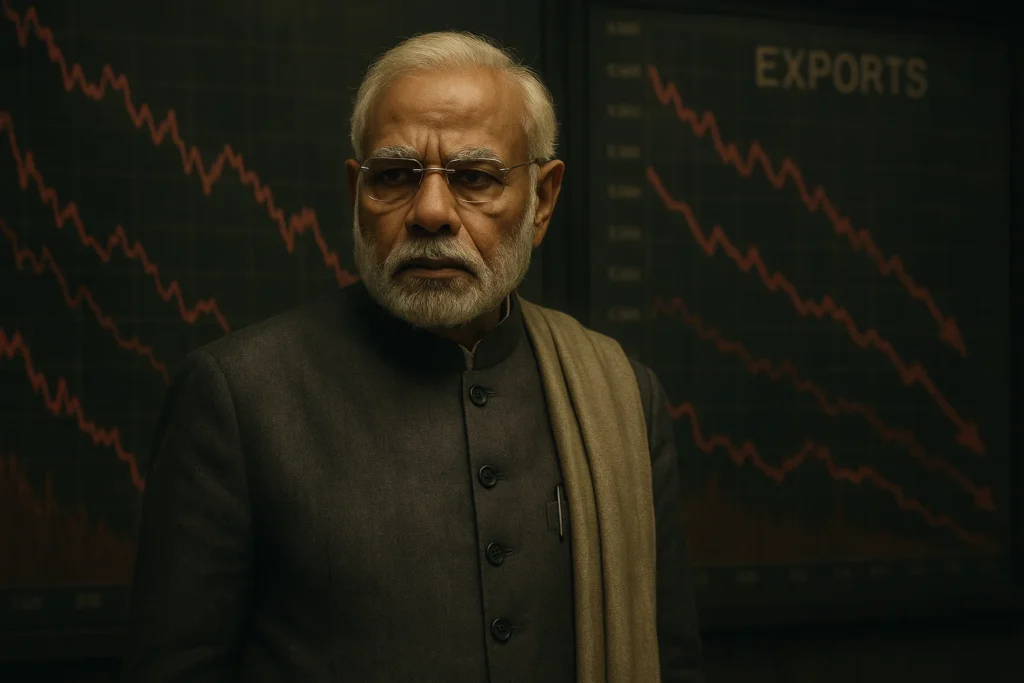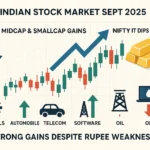Introduction
The India $2 trillion export target by 2030 has long been positioned as a bold vision to transform the nation into a global trade powerhouse. However, recent developments threaten to derail that ambition. On August 27, the United States imposed sweeping 50% tariffs on a wide range of Indian exports, doubling the previous rate of 25%. With the U.S. accounting for 20% of India’s merchandise exports and contributing nearly 2% to GDP, the shock is not just about trade—it directly impacts sectors, companies, and export stocks that investors track closely.
In this new reality, India’s dream of scaling its exports to $2 trillion looks increasingly fragile, and certain stocks may no longer remain as attractive as before.
India’s Export Ambition vs Harsh Reality
India has spent the past decade building up its exports, but the progress has been uneven. Imports have grown faster, leading to a widening trade deficit. In FY 2023–24, the merchandise trade deficit stood at US$ 241.14 billion, which worsened to US$ 282.83 billion in FY 2024–25.

This imbalance underscores how difficult the road to the India $2 trillion export target already was, even before new tariffs hit. For investors, this raises red flags about the long-term performance of some export stocks heavily reliant on overseas markets.
The Tariff Shock – A Turning Point
The new 50% tariff imposed by the U.S. could slash India’s merchandise exports to America by 40–45% in FY 2025–26. The sectors most affected—textiles, gems and jewelry, seafood, furniture, and machinery—are among India’s largest employers and contributors to export earnings.
With the U.S. being India’s single biggest export destination, the India $2 trillion export target appears even less achievable. For investors, this directly translates to pressure on export stocks from these industries, with risks of margin compression, declining volumes, and possible de-rating in valuations.
Government’s Countermove – Export Promotion Mission
In response, the Government of India is finalising a ₹25,000 crore Export Promotion Mission (EPM) to be spread over six years (2025–31).
- Niryat Protsahan will boost the soft side of exports: branding, market development, credit support, and MSME handholding.
- Niryat Disha will strengthen the hard side: ports, logistics, warehousing, and digital customs.
While these schemes may help in the medium to long term, they will take time to show results. For now, the immediate impact of tariffs will weigh on several export stocks tied to the U.S. market.
Stocks That May Lose Investor Appeal
Here are the sectors and export stocks most at risk:
| Sector | Example Stocks | U.S. Exposure | Why Less Attractive Now |
|---|---|---|---|
| Textiles & Apparel | Welspun India, KPR Mills, Arvind | High share of exports go to U.S. retailers | Rising tariffs will erode margins and pricing power |
| Gems & Jewelry | Titan, Rajesh Exports | U.S. is a top buyer of polished diamonds & jewelry | Demand may shrink due to higher import costs |
| Seafood | Avanti Feeds, Apex Frozen Foods | Large proportion exported to U.S. markets | Highly tariff-sensitive, risk of sharp export decline |
| Engineering & Machinery | Bharat Forge, Lakshmi Machine Works | Machinery exports face strong U.S. demand | Higher costs will make products less competitive |
| Furniture (largely unlisted) | Indirect impact on logistics players | Dependent on U.S. demand | Supply chain and warehousing challenges |
For investors, these export stocks may not deliver the same growth they once promised. While some companies have diversified markets, the scale of U.S. exposure means near-term headwinds are unavoidable.
Safer Alternatives in the Export Story
While many export stocks may lose their shine, some related plays could emerge stronger in the long term:
- Logistics & Ports: Adani Ports, CONCOR, and Gateway Distriparks could benefit from the infrastructure spending under Niryat Disha.
- Banks/NBFCs with MSME focus: SBI, HDFC Bank, and SIDBI-linked institutions could gain from credit support measures under Niryat Protsahan.
However, these are defensive angles. The broader picture remains that the India $2 trillion export target is slipping further away, making export-heavy companies a riskier bet.
Investor Takeaway
The India $2 trillion export target was already ambitious, but the new tariff regime makes it highly improbable in the current timeline. For investors, this means:
- Avoid overexposure to export stocks tied heavily to U.S. demand.
- Watch out for margin compression in textiles, gems, seafood, and engineering companies.
- Consider safer domestic-demand-driven companies until clarity emerges on trade negotiations.
Conclusion
The convergence of aggressive U.S. tariffs and India’s widening trade deficit has created a roadblock for the India $2 trillion export target. While the ₹25,000 crore Export Promotion Mission is a step in the right direction, execution will take years.
For now, investors should reassess their positions in export stocks most exposed to the U.S. market. Until the policy measures kick in and global trade dynamics ease, these stocks are unlikely to remain as attractive as they once were.
The big lesson? In a post-tariff world, intent alone will not suffice—execution and diversification will decide which companies survive and which ones falter.
FAQs
1. What is the India $2 trillion export target?
It is India’s goal to scale total exports to $2 trillion by 2030.
2. Why is the India $2 trillion export target under threat?
Because the U.S. recently doubled tariffs to 50% on many Indian goods, hitting key export sectors.
3. Which sectors are most impacted by the U.S. tariffs?
Textiles, gems & jewelry, seafood, machinery, and furniture.
4. How will the tariffs affect export stocks?
Export stocks tied to the U.S. market may see reduced demand, margin pressure, and slower growth.
5. What is the Export Promotion Mission (EPM)?
A ₹25,000 crore government program (2025–31) to boost Indian exports through two flagship schemes.
6. What is Niryat Protsahan?
A scheme under EPM focusing on marketing, credit support, MSMEs, and market development.
7. What is Niryat Disha?
A scheme under EPM aimed at improving logistics, ports, warehousing, and digital customs.
8. Which export stocks may lose investor appeal?
Welspun India, KPR Mills, Titan, Rajesh Exports, Avanti Feeds, and Bharat Forge are vulnerable.
9. Are there any safer alternatives for investors?
Yes, logistics players like Adani Ports and CONCOR may benefit from infrastructure upgrades.
10. What should investors do now?
Reduce overexposure to U.S.-dependent export stocks and focus on companies with strong domestic demand.
Related Articles
Trump’s Tariff Shockwave: How Indian Stocks & Sectors Will Be Hit or Rise
Tariff and Great Depression: Will History Repeat?
Tariff Paused: A Golden Opportunity for Indian Stocks?






